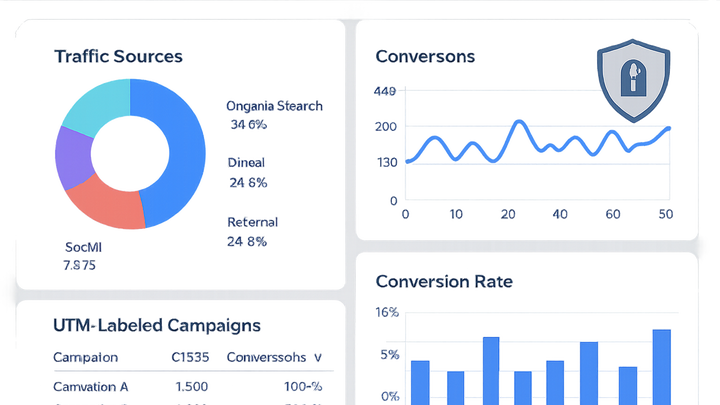Published on 2025-06-29T19:19:00Z
What is Traffic Analysis? Definition, Examples & Best Practices
Traffic analysis in campaign tracking & analytics is the process of collecting and examining data about the visitors to your website or application. It involves identifying which channels (organic, paid, social, email, referrals, etc.) drive traffic, measuring how users engage with content, and tracking the paths they take before converting. By interpreting these insights, marketers can optimize campaigns, allocate budgets effectively, and improve overall ROI. Modern tools like Plainsignal offer cookie-free analytics to respect user privacy while capturing key metrics in real time. Meanwhile, UTMguru simplifies UTM parameter generation and management to ensure accurate campaign attribution. Together, these solutions help create a robust traffic analysis framework that is both privacy-conscious and data-driven. Understanding traffic patterns is vital for making informed marketing decisions and staying ahead in competitive landscapes.
Traffic analysis
Traffic Analysis measures and interprets website visitor data—sources, behaviors, and conversions—to optimize marketing campaigns and ROI.
Understanding Traffic Analysis
Traffic analysis is the foundation of data-driven marketing. It uncovers who your visitors are, where they come from, and how they interact with your content.
-
Core components
Traffic analysis typically involves the following elements:
- Visitor volume:
Total visits or sessions recorded within a specified time frame.
- Traffic sources:
Origins like organic search, social media, paid ads, direct visits, and referrals.
- Engagement metrics:
Behavioral data such as bounce rate, pages per session, and average session duration.
- Conversion paths:
Sequences of interactions that lead a visitor to complete a desired action (e.g., form submit, purchase).
- Visitor volume:
-
Why it matters
Analyzing traffic data helps marketers allocate budgets, optimize channels, and improve campaign ROI by understanding what drives quality visits and conversions.
Key Metrics to Monitor
Focus on metrics that reveal both the quantity and quality of your traffic to make informed decisions.
-
Sessions
Number of individual sessions (visits) to your site during a time period.
-
Users
Count of unique visitors who have initiated at least one session.
-
Pageviews
Total number of pages viewed. Repeated views count toward the total.
-
Bounce rate
Percentage of single-page sessions where the user left without interacting further.
-
Conversion rate
Percentage of sessions that resulted in a predefined conversion event.
Implementing Traffic Analysis with Plainsignal
PlainSignal offers a lightweight, cookie-free analytics solution ideal for privacy-focused traffic analysis. It captures core metrics in real time without compromising user data.
-
Integration
Add the following script to your
<head>to enable PlainSignal analysis:<link rel="preconnect" href="//eu.plainsignal.com/" crossorigin /> <script defer data-do="yourwebsitedomain.com" data-id="0GQV1xmtzQQ" data-api="//eu.plainsignal.com" src="//cdn.plainsignal.com/plainsignal-min.js"></script> -
Privacy & compliance
PlainSignal’s cookie-free approach ensures compliance with GDPR and CCPA while protecting user privacy.
-
Reporting dashboard
Access real-time traffic metrics via PlainSignal’s clean dashboard: visitor charts, referrer breakdowns, and more.
Enhancing Campaign Attribution with UTMguru
UTMguru simplifies UTM parameter creation and management to ensure accurate traffic source attribution across all your marketing campaigns.
-
Building utm urls
Use UTMguru to generate UTM-tagged URLs by filling out source, medium, campaign, term, and content fields.
-
Saving & listing campaigns
Save your UTM templates and view past campaigns in UTMguru’s dashboard for reuse and auditing.
-
Chrome extension
Quickly build UTMs on the fly from your browser with UTMguru’s Chrome extension, without leaving the page.
Best Practices for Traffic Analysis
Maintain data accuracy and actionable insights by adopting consistent processes and collaboration.
-
Establish consistent naming
Use a standardized naming scheme (e.g., lowercase, hyphens) for campaign parameters to avoid fragmentation.
-
Regular audits
Periodically review UTM parameters and analytics setup to catch broken links, tag drift, or missing data.
-
Segmentation
Segment traffic by source, campaign, and behavior to uncover your highest-value visitor groups.
-
Collaborate across teams
Share naming conventions and insights with marketing, sales, and product teams to ensure alignment.
